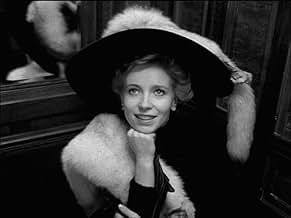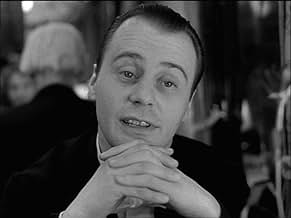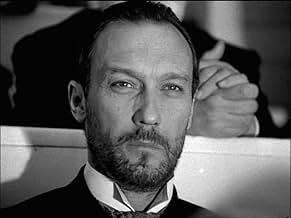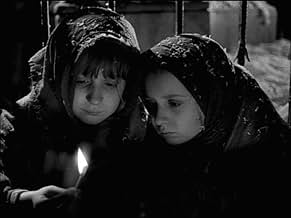Az én XX. századom
- 1989
- 1 घं 42 मि
IMDb रेटिंग
7.0/10
2.1 हज़ार
आपकी रेटिंग
अपनी भाषा में प्लॉट जोड़ेंTwo twin sisters, who grew up separately, Dóra, a pseudo-aristocrat, and Lili, an anarchist bomber, are reunited through Z, a mysterious traveller of the luxurious Orient-Express.Two twin sisters, who grew up separately, Dóra, a pseudo-aristocrat, and Lili, an anarchist bomber, are reunited through Z, a mysterious traveller of the luxurious Orient-Express.Two twin sisters, who grew up separately, Dóra, a pseudo-aristocrat, and Lili, an anarchist bomber, are reunited through Z, a mysterious traveller of the luxurious Orient-Express.
- पुरस्कार
- कुल 1 जीत
फ़ीचर्ड समीक्षाएं
In My Twentieth Century, the world begins to move electrically - dramatically, beautifully shown in electric dance costumes, marching bands and mirrored halls, spurred by a sad-faced (I really liked his face) actor as Edison, intoning toward the end that As god is magnificent for his creation, man is magnificent in learning how to harness it (not quite the line, but best I can do).
Meanwhile, twin orphan girls fall asleep, like the match girl in the Andersen story, hoping a lighted match will warm them on a snowy eve. Stars and a miraculous donkey lead well-dressed men to carry them to safety but in separate directions of compass and life. Later, one of them, now a poor anarchist, drops her copy of Kropotkin's "Mutual Aid" in the snow where a man finds it, reads it's message of cooperation and play among animals (in great distinction to the then popular capitalist theory of 'social darwinism' - "survival of the fittest" and "red in tooth and claw") through the night and becomes entwined in the narrative as he meets one of the young women and then the other, none of them knowing of the twin presence.
Kropotkin's observations, while brought in by a revolutionary, seemed to be the narrative of a playful counterpoint to the technologically modern world. I didn't see his words used as narrative as a turning back so much as a development that goes arm in arm with the other. His observations of rabbits "so drunk with play" they lack "fear of the fox" are juxtaposed with scenes of the man and the young women as they tryst happily and alternately take offense. While the anarchist seemed put off by the man's brusque manner (he had justifiably mistaken her for the more libidinous sister) the affairs seemed modern and innocent in consequence - no french lieutenant's woman fate, no scarlet letter. While Edison prepares to send a message by wire around the world, the young women and their man unite (it's vague but...) and wake to scenes of white pigeons in flight also carrying messages. Edison even confronts one before sending his own message.
Meanwhile, twin orphan girls fall asleep, like the match girl in the Andersen story, hoping a lighted match will warm them on a snowy eve. Stars and a miraculous donkey lead well-dressed men to carry them to safety but in separate directions of compass and life. Later, one of them, now a poor anarchist, drops her copy of Kropotkin's "Mutual Aid" in the snow where a man finds it, reads it's message of cooperation and play among animals (in great distinction to the then popular capitalist theory of 'social darwinism' - "survival of the fittest" and "red in tooth and claw") through the night and becomes entwined in the narrative as he meets one of the young women and then the other, none of them knowing of the twin presence.
Kropotkin's observations, while brought in by a revolutionary, seemed to be the narrative of a playful counterpoint to the technologically modern world. I didn't see his words used as narrative as a turning back so much as a development that goes arm in arm with the other. His observations of rabbits "so drunk with play" they lack "fear of the fox" are juxtaposed with scenes of the man and the young women as they tryst happily and alternately take offense. While the anarchist seemed put off by the man's brusque manner (he had justifiably mistaken her for the more libidinous sister) the affairs seemed modern and innocent in consequence - no french lieutenant's woman fate, no scarlet letter. While Edison prepares to send a message by wire around the world, the young women and their man unite (it's vague but...) and wake to scenes of white pigeons in flight also carrying messages. Edison even confronts one before sending his own message.
At the turn of the century, there were terrorists with bombs, a magic called electricity and of course, there was love, represented by twin sisters born - one a courtesan, the other a political feminist. It was a time when everything was black and white. This movie does what movies are supposed to do - to make you dream and think and feel about our experiences on earth. Like great dreams, you may not fully understand them, until you reflect and see it again.
First time I saw this at the SF Film Fest was a 1989 preview. Ten minutes into it the projector shut down. "We apologize, but we started with the second reel first. We don't have enough time to show it now, but check back for a reschedule." Talk about feeling confused and having low expectations with other films to see, for some reason I came back; I suppose to get my money's worth. Maybe it put the hook in me. So it opens with a dreamlike child's instrument playing, and stock footage of a circus entertainer putting his head in a canon, holding a torch to the fuse - all playing in reverse cycles. The film challenges you deceptively with old film tricks, but they are well thought out. A modern director would plod epic beginning - Edison's first public display of electric light. Enyedi as light as a snowflake directs us to the first magnificent scene set at night. People in period 1880's clothing see light bulbs for the first time. Playing Stars and Stripes, a band marches forward, mostly Negroes lit up, powered by a following horse-drawn cart holding Edison's sinister sounding generator. Electricity! With creative liberties, the director swiftly takes us from New Jersey to Hungary, where twins are born to sell matches in the night snow only to be driven away by a constable. They huddle to strike a flame; curious, innocent faces are brightened. Matches!
The director uses the spark of these twins as two different female natures to advance us into the birth of the twentieth century. A must see for anyone who values cinema.
First time I saw this at the SF Film Fest was a 1989 preview. Ten minutes into it the projector shut down. "We apologize, but we started with the second reel first. We don't have enough time to show it now, but check back for a reschedule." Talk about feeling confused and having low expectations with other films to see, for some reason I came back; I suppose to get my money's worth. Maybe it put the hook in me. So it opens with a dreamlike child's instrument playing, and stock footage of a circus entertainer putting his head in a canon, holding a torch to the fuse - all playing in reverse cycles. The film challenges you deceptively with old film tricks, but they are well thought out. A modern director would plod epic beginning - Edison's first public display of electric light. Enyedi as light as a snowflake directs us to the first magnificent scene set at night. People in period 1880's clothing see light bulbs for the first time. Playing Stars and Stripes, a band marches forward, mostly Negroes lit up, powered by a following horse-drawn cart holding Edison's sinister sounding generator. Electricity! With creative liberties, the director swiftly takes us from New Jersey to Hungary, where twins are born to sell matches in the night snow only to be driven away by a constable. They huddle to strike a flame; curious, innocent faces are brightened. Matches!
The director uses the spark of these twins as two different female natures to advance us into the birth of the twentieth century. A must see for anyone who values cinema.
electricity...the stars talking...a dog with electrodes on its head...a whore and a terrorist...the pigeons...the donkey...siberia...what the freakin hell? this one either went right over my head. nothing else to say about this one but i'm supposed to fill up 4 lines. rating -6/10.
A film of great charm, beauty and invention and yet it's almost totally unknown, Ildiko Enyedi's debut "My Twentieth Century" is ripe for rediscovery. It's the story of twin girls, Dora and Lili, (both played by Dorotha Segda), born in Budapest in 1880 but separated in early childhood, one growing up to be an anarchist, the other a courtesan. It's also the story of the inventions of one Thomas Edison and it's wonderfully shot in black and white, with nods to the silent cinema, by Tibor Mathe. Darting all over the place with no concessions to reality it feels, at times, like it could have been made by Max Ophuls early in his career and at other times like something from the Czech New Wave and you might even be forgiven for thinking that Miguel Gomes may have seen this before making "Tabu". Gorgeous, mysterious and unmissable.
Hungary's submission for Best Foreign Language Film to the 62nd Academy Awards is a kaleidoscopic look at the turn of the last century. Ildikó Enyedi's "Az én XX. Századom" ("My 20th Century" in English) mostly focuses on a pair of sisters - one an aristocrat, the other an anarchist - while also showing the technological innovations that came about as the nineteenth century was ending. The movie incorporates cats, a donkey, and even sexuality to tell its multi-layered story, all done to perfection. It might be hard to take in, but you should still see it. The cast includes Dorota Segda, Oleg Yankovsky, Paulus Manker, Péter Andorai, Gábor Máté and Gyula Kéry.
It was probably appropriate to release this depiction of a new era just as Hungary was about to enter a new era, breaking free of the Soviet boot. Enyedi put off directing for a while after this, returning with 2017's Academy Award-nominated "On Body and Soul", about a relationship between two people suffering from disabilities.
It was probably appropriate to release this depiction of a new era just as Hungary was about to enter a new era, breaking free of the Soviet boot. Enyedi put off directing for a while after this, returning with 2017's Academy Award-nominated "On Body and Soul", about a relationship between two people suffering from disabilities.
क्या आपको पता है
- ट्रिवियाVoted as one of the "12 Best Hungarian Films" ("New Budapest 12") by Hungarian filmmakers and critics in 2000.
- गूफ़The film takes place around 1900. In the projection room scene, among Méliès' films, there is an extract from "The General" by Buster Keaton which was shot in 1926. That is 26 years later.
- कनेक्शनFeatured in Final Cut: Hölgyeim és uraim (2012)
- साउंडट्रैकMacbeth, Act 3: Coro e ballabile
Ondine e silfidi""
Written by Giuseppe Verdi
Performed by Andrea Mate, Budapest Symphony Orchestra, Hungarian Radio and Television Chorus, Istvan Gati, Janos Bandi, Janos Tóth, Katalin Pitti, Kolos Kováts, Lamberto Gardelli, Mária Zádori, Peter Kelen, Piero Cappuccilli, Sylvia Sass, Tamás Bátor
टॉप पसंद
रेटिंग देने के लिए साइन-इन करें और वैयक्तिकृत सुझावों के लिए वॉचलिस्ट करें
- How long is My Twentieth Century?Alexa द्वारा संचालित
विवरण
बॉक्स ऑफ़िस
- US और कनाडा में सकल
- $6,82,016
- चलने की अवधि1 घंटा 42 मिनट
- रंग
- ध्वनि मिश्रण
- पक्ष अनुपात
- 1.37 : 1
इस पेज में योगदान दें
किसी बदलाव का सुझाव दें या अनुपलब्ध कॉन्टेंट जोड़ें




























